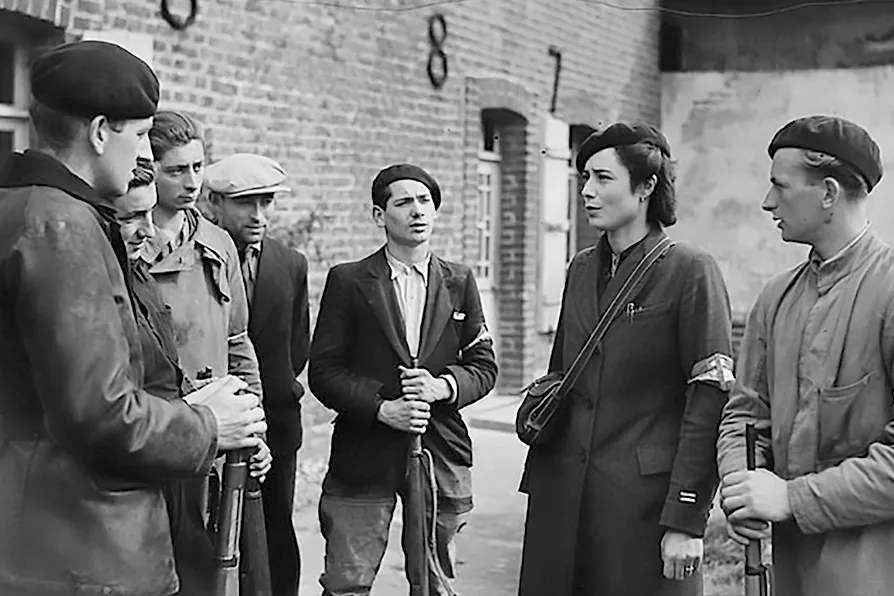From London’s holly-sellers to Engels’s flaming Christmas centrepiece, the plum pudding was more than festive fare in Victorian Britain, says KEITH FLETT
JOHN ELLISON recalls the momentous role of the French resistance during WWII

 LEGENDS: A Maquis detachment in La Tresorerie hamlet near Boulogne-sur-Mer, Pas-de-Calais, September 14 1944, pic: Donald I Grant, Department of National Defence/CC
LEGENDS: A Maquis detachment in La Tresorerie hamlet near Boulogne-sur-Mer, Pas-de-Calais, September 14 1944, pic: Donald I Grant, Department of National Defence/CC
ON THE 80th anniversary of Victory in Europe Day, the historical importance of French resistance to Nazi occupiers and their Petainist delegates and collaborators, both for France’s own liberation and for its post-war political future, should not be forgotten.
In Britain the real story has been too much buried out of sight. Certainly it included French people risking their lives to aid Britain’s Special Operations Executive (SOE) agents and stranded British aircrews, but the wider picture embraced a whole range of resistance activities, driven both by detestation of Nazi occupation, and by hopes for a more radical and democratic France.
The list of resistance groups across France is long. Within them could be found communists, left socialists, radical Catholics, nationalists (some not obviously “political”), and others highly conservative, as was “noble anachronism” General Charles de Gaulle.
Jewish people, both French and foreign, played their part. All shared in the eventual liberation of France at a cost which included the shooting of around 30,000 resisters and many more slow deaths in German concentration camps.
The pre-war context is omitted here to give more space to the Resistance narrative itself. In September 1939, as the “war in waiting” against Germany began, the French Communist Party (which had more than 70 parliamentary deputies), was outlawed, with many arrests, despite its anti-fascist history and character, and was thereby disabled.
Its members were also considerably immobilised as a result of the connected message from Moscow, following the Soviet-German neutrality pact of August 23 1939, that the war was “imperialist” (in part a valid argument), and therefore was not for them.
France’s military defeat came within five weeks of the May 1940 Nazi invasion and forced the British supporting army to escape, mostly via Dunkirk. Although Nazi Germany was to occupy Paris and the north, the “Free Zone,” ruled by General Philippe Petain, in the south was really a form of delegated occupation until full Nazi takeover in November 1942. De Gaulle took refuge in Britain and on June 18 1940 broadcast his promise to continue the fight.
Pre-war France had been divided both in class and political terms. As history professor Marc Bloch (executed in June 1944 for his part in the Resistance) wrote in his late 1940 memoir: “The bourgeoisie either refused to take the masses seriously, or they trembled before their implied threat. Driven to despair of their own future, they ended by despairing of their own country.”
Formidable journalist-historian Alexander Werth, in his history of France from 1940, was to write, in relation to later developments, that “the upper bourgeoisie was, in the main, indifferent, if not downright hostile to the Resistance, with its talk of revolution and a ‘New Deal’.”
As early as October 1940 a young communist, Guy Moquet, was arrested with two friends for tossing anti-Nazi leaflets from their bicycles in Paris. He was later executed.
On November 11, the anniversary of WWI armistice, student demonstrators in the Champs-Elysees bearing two sticks — “deux gauls” (a cryptic tribute to de Gaulle) — were ferociously suppressed by the Germans with shootings, beatings and imprisonments.
In late December many tiny flowers were pinned on to a grim street poster announcement in Paris of the execution of Jacques Bonsergent, 28, for assaulting a German (there’s now a square and Metro station named in his honour).
Elsewhere in the country, acts of railway and other sabotage took place over the months and years to come with much retribution. Strike action by workers was another form of resistance.
Through local and individual initiatives, some Jewish people were saved from the horrifying round-ups and deportations to Nazi death camps. One tactic employed was to forge identity papers.
An aspect of the struggle that could be better known was the circulation of anti-Nazi material in the form of news bulletins, leaflets, fiction and even poetry.
From December 1940 one paper — Resistance — was circulated by a group linked to the Musee de l’Homme in Paris, but after several issues, betrayal of those responsible led to arrests and executions. One Musee arrest was of art historian Agnes Humbert, imprisoned and not released until France’s full liberation four years later. Her moving memoir was published in 1946.
The necessity for secrecy consolidated by pseudonyms became obvious. It was in this situation that a book illustrator and engraver, Jean Bruller, who used several pseudonyms, took the initiative in organising the secret printing and dissemination of a series of short books which challenged the Nazi occupation in part through demonstrating the continuing vitality of French national culture.
The first volume circulated from spring 1942 was Bruller’s own Le Silence de la Mer/The Silence of the Sea he published under a pseudonym Vercors the name of a plateau in the Massif Central, where two years later the Maquis fought a legendary battle against Nazi forces. The left-leaning Bruller had no difficulty in working alongside communists at one end of the spectrum and conservative nationalists at the other.
Le Silence de la Mer centred on the billeting of a cultured German officer on a Frenchman’s middle-class country home.
The Frenchman was the narrator, who denied communication other than in the form of polite, dignified silence, bringing respect from the France-loving German. Following the Nazi onslaught on the Soviet Union in June 1941, a seminal moment arose when the officer, finally understanding that his Nazi masters wished to destroy France’s spirit as well as to own the country, was distraught with distress.
Other productions followed in summer 1943. One was a collection of poems, L’Honneur des Poetes, edited anonymously by communist poet Paul Eluard, separately famous for his poem Liberte. Another was by left Catholic writer Francois Mauriac (a laureate of the Nobel Prize in Literature) — The Black Notebook. Many more were to come.
The full story was revealed in a fine memoir by Bruller, published in the mid-1960s as the La Bataille du Silence, and later in English, faithfully, as The Battle of Silence. He was never arrested.
In late May 1943 De Gaulle’s representative Jean Moulin (soon to be tragically betrayed and tortured to death by the Nazis), achieved unity across the Resistance movement through a meeting in Paris of a mix of leaders of trade unions, resistance groups and political parties.
Here was formed the National Council of the Resistance — the NCR — which agreed a “Charter” 10 months later. This committed the NCR to press for a de Gaulle-led republican government which would implement a post-war reform programme subordinating “private interests to the public interest,” nationalising “all the great monopolised means of production,” not excluding insurance companies and the big banks. Abroad, the Charter called for the extension of political, social and economic rights to French colonies.
The D-Day landing of June 6 1944 of course played a key part in France’s liberation, and behind the scenes, US disapproval of a provisional De Gaulle authority, preferring an Allied Military Government (not ruling out power-sharing with Petain either), was overcome by the Resistance movement.
The liberation of Paris in 1944 was naturally a high point. Heading the thousands-strong Paris resistance army was Colonel Henry Rol-Tanguy, a former Spanish International Brigader. The NCR backed his call for insurrection on August 18, and on the 21st barricades were thrown up in many places. His calls for help from Allied forces brought in General Leclerc’s division on the 23rd, and de Gaulle’s Victory Parade took place on the 26th.
In April 1945, in a government of “National Unanimity” headed by “seventeenth century” de Gaulle, the health and air ministries were allocated to communists.
The NCR’s “New Deal” for France was to a large extent blocked post-war by the siren call of the cold war and another seeking maintenance of France’s colonial empire, both calls supported by US Marshall Aid funding.
France’s ruling class was back in business. But the words of the Charter had been uttered. They demonstrated the leading presence of the left in the Resistance struggle, a struggle which de Gaulle sought to present as purely French, but which had also engaged Polish units, German communists and Spanish Republicans. A struggle not to be forgotten.

The Morning Star's Danish sister paper ARBEJDEREN on when the people of Copenhagen triumphed over the occupying forces

Communists lit the spark in the fight against Nazi German occupation, triggering organised sabotage and building bridges between political movements. Many paid with their lives, says Anders Hauch Fenger

The pivotal role of the Red Army and sacrifices of the Russian people in the defeat of Nazi Germany must never be forgotten, writes DR DYLAN MURPHY











